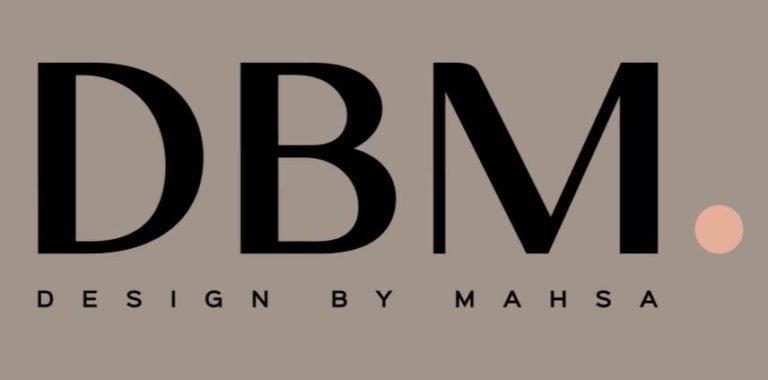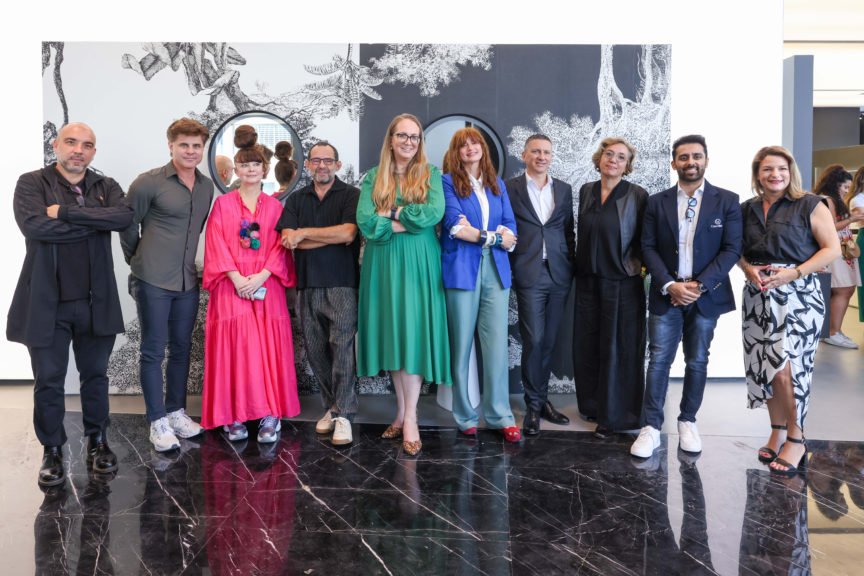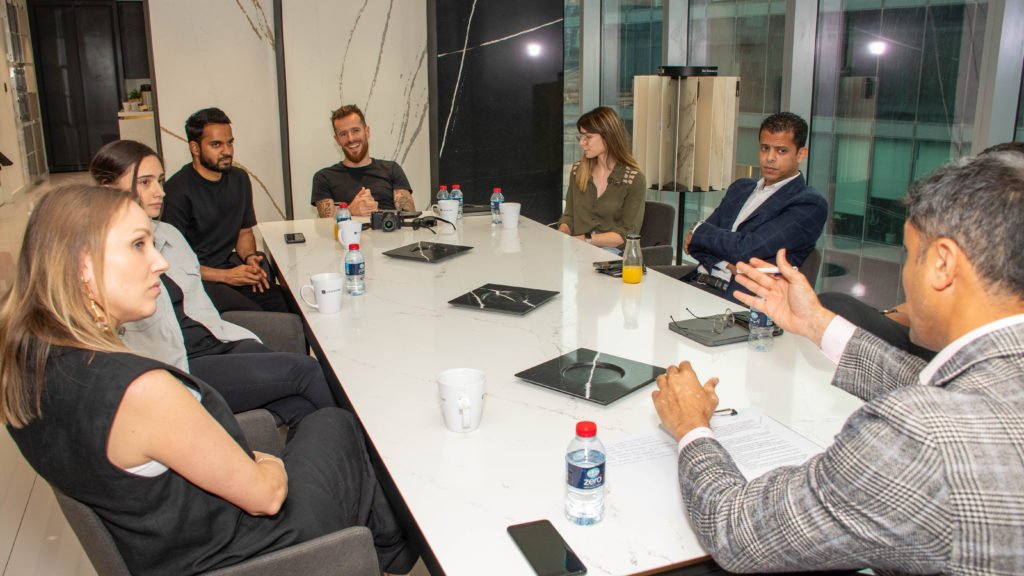As four influential figures stride into the studio, the intrigue is palpable. What links these diverse individuals? Is it the exchange of amusing anecdotes regarding clients with impractical timelines and budgets, or perhaps the presence of the Compass’ uniquely beneficial capabilities adding an intriguing layer to the mix?
With the discussion unfolding, the complexities of the region’s interior design and construction landscape takes centre stage. Both Design-Bid-Build and Design & Build projects have left their mark, shaping the industry’s evolution. Yet, in the past three years, has one approach surged ahead in prominence? Are these approaches indicative of distinct client preferences and priorities, or do their trajectories inevitably converge? How do PMCs and Fit-Out Contractors fit into this narrative?
Top: Mahsa Gholizadeh, Founder of Design by Mahsa; Mahesh Kamath, General Manager at Xworks
Bottom: Richard Cushnan, Regional Director of Construction Management at Compass; Mira Kurniawan, Associate Design Director, DWP
Deciphering Design & Build vs. Design-Bid-Build
Finding the Ideal Construction Method
Mira Kurniawan, Associate Design Director at DWP, highlights the choice between Design & Build and Design-Bid-Build often depends on project scope, budget, and timelines. “In my experience, Design & Build thrives in the commercial, retail, and F&B sectors due to its timeline and ROI advantages. However, for sectors like hospitality and healthcare, Design-Bid-Build offers better results due to extensive stakeholder approvals,” she explains.
Mahesh Kamath, General Manager at Xworks, agrees, stressing the importance of timelines for clients. He mentions that depending on timeline constraints, clients may opt for their Design & Build services to streamline design strategy and save time.
Mahsa Gholizadeh, Founder of Design by Mahsa, adds “Especially in commercial projects, due to the lease constraints, clients often want to move in yesterday,” she remarks with a laugh.
“In my experience, Design & Build thrives in the commercial, retail, and F&B sectors due to its timeline and ROI advantages. However, for sectors like hospitality and healthcare, Design-Bid-Build offers better results due to extensive stakeholder approvals.“
– Mira Kurniawan, Associate Design Director at DWP
Comparing Design & Build vs. Design-Only Approaches
Balancing Creativity and Budget
While discussing the benefits of a Design & Build approach, Mahesh highlights perks such as enhanced client interaction and better control over budget and design scope. “Compared to Design-Only firms, we have a better grasp of the client’s background and building specifications, enabling us to incorporate changes early in the design,” he explains.
Mira, from a Design-Only perspective, stresses that as design consultants, their primary focus is on creativity. However, they also prioritise understanding the client’s budget before delving into specifics. Highlighting potential challenges, she notes instances where clients desire a five-star hotel design without clarity on whether the budget is more suited for a five-star hotel or a more modest three-star establishment.
“Compared to Design-Only firms, we have a better grasp of the client’s background and building specifications, enabling us to incorporate changes early in the design.“
– Mahesh Kamath, General Manager at Xworks
“Initially, our focus is on creative exploration. However, as we progress, we ensure our proposals align with budgetary considerations. Preserving the core identity of a property is non-negotiable for us and we achieve that through strategic compromises,” she adds.
Mahsa notes the increased responsibility. “As designers, we need to do our homework to ensure that the project is not only aesthetically pleasing and practical, but it also aligns with the client’s budget. Normally, we ensure whatever you see in that initial render is within the budget and it can come to life,” she states.
The Fourth Pillar in Project Success
Role of Construction Management Consultancy in Project Delivery
Richard Cushnan, Regional Director of Construction Management at Compass, the unassuming fourth panellist, concurs, emphasising Compass’ commitment to preserving the creative vision while managing budget constraints. “We work hand-in-hand to ensure the project’s creative integrity isn’t compromised by budget restrictions,” he explains. “Compass can always manage costs and value engineer the proposal back to a more workable level. The ultimate goal is not about Compass being successful; it’s about everybody being successful together,” Richard asserts.
Highlighting the growing demand for turn-key Construction Management, Richard explains, “Construction Management and Fit-Out for Compass were introduced to fill a market gap for start-to-finish solutions for clients. We manage contractors, designers, supply chain, procurement, and assume all risk for the client.”
“We work hand-in-hand to ensure the project’s creative integrity isn’t compromised by budget restrictions. Compass can always manage costs and value engineer the proposal back to a more workable level. The ultimate goal is not about Compass being successful; it’s about everybody being successful together.“
– Richard Cushnan, Regional Director of Construction Management at Compass
Sharing an example, Richard reveals instances where clients lack delivery experience, leading to discrepancies between expectations and practical needs. Collaborating with design teams and contractors allows them to find viable solutions, fostering client understanding and alignment among stakeholders.
“We workshop the project by being transparent and open with the client,” Richard explains. “For instance, designers may specify high-spec, expensive furniture brands that don’t align with the project’s timeline or budget. We promptly address this by presenting alternatives and transparently explaining to the client, ‘You have this black chair and this black chair; however, this option costs half the price, looks the same, functions similarly.”

“We workshop the project by being transparent and open with the client. For instance, designers may specify high-spec, expensive furniture brands that don’t align with the project’s timeline or budget. We promptly address this by presenting alternatives and transparently explaining to the client, ‘You have this black chair and this black chair; however, this option costs half the price, looks the same, functions similarly.“
– Richard Cushnan, Regional Director of Construction Management at Compass
PMC’s Crucial Role in Securing Projects
Standardisation and Fair Competition
In competitive scenarios where multiple contractors vie for the same project, standardisation through a consultancy involvement is crucial. This ensures all contractors work towards one approved conceptual design, allowing clients to fairly compare pricing differences. Mahesh illustrates this with a straightforward example: if one contractor proposes a 5-star hotel design while another suggests a 3-star hotel design, pricing comparisons become unfair, reducing the chances of winning projects.
Reflecting on a Design-Bid-Build project tender, Mahesh recounts an incident where both final bids exceeded the client’s budget, requiring value engineering. “We made adjustments and resubmitted our quote. In contrast, our competitor altered the design and submitted a new proposal, which the client ultimately accepted. This experience raised questions about the purpose of the initial design intent. Had we known about the flexibility to modify the design, we could have leveraged our in-house design team to propose alternatives,” he reveals.

“We made adjustments and resubmitted our quote. In contrast, our competitor altered the design and submitted a new proposal, which the client ultimately accepted. This experience raised questions about the purpose of the initial design intent. Had we known about the flexibility to modify the design, we could have leveraged our in-house design team to propose alternatives.“
– Mahesh Kamath, General Manager at Xworks
In such cases, Compass’s role becomes pivotal. Richard agrees, emphasising that in such a scenario, their assessment would prioritise the value engineering proposal aligning with the original design intent. Disregarding the designer’s creativity would result in a loss for all involved parties. Additionally, the designer would need to approve materials regardless. However, the client’s design preferences ultimately supersede all other considerations, he notes.
Ensuring Post-Delivery Success
Clarifying Roles and Choosing the Right Partner
“Sometimes clients misunderstand the roles of design representation or site supervision with construction management,” Mahsa explains, recalling a large-scale fit-out project over a 10,000-square-metre office space. “Once they mobilise on-site, they expect us to manage the project for them. Then it is our job to educate them that we’re not a PMC and we usually recommend our trusted partners to be involved to make the process smoother.”
Mira agrees revealing if given the choice between a Fit-Out Contractor and a Construction Management solution for execution, she would lean towards a PMC. “Without proper management of workflow, design approvals, and handovers, project success is compromised. Having a PMC helps to mediate in terms of construction and value engineering, ultimately making our dream a reality,” she explains.

“Sometimes clients misunderstand the roles of design representation or site supervision with construction management,” Mahsa explains, recalling a large-scale fit-out project over a 10,000-square-metre office space. “Once they mobilise on-site, they expect us to manage the project for them. Then it is our job to educate them that we’re not a PMC and we usually recommend our trusted partners to be involved to make the process smoother.“
– Mahsa Gholizadeh, Founder of Design by Mahsa
Beyond Borders: Leveraging Global Partnerships in Design-Bid-Build Projects
Seizing Growth Opportunities with PMC’s Local Expertise
Regarding the Design-Bid-Build process, Mahesh anticipates significant potential growth in traditional bidding. He attributes this to the ability of global companies to enter the market with trusted partners like Compass, despite their lack of local presence. Beyond approvals and management aid, the PMC can aid in understanding local challenges, building trust, and ensuring aligned mindsets for easier and faster communication.
Richard further elaborates on how the UAE differs significantly from other Gulf markets like Saudi Arabia, Oman, Bahrain, and Qatar. With experience in these regions as well, Compass can offer a pre-qualified supply chain, ensuring clients aren’t blindsided by regional differences, preventing unrealistic expectations based on European standards.
“We’ve had a number of examples where contrary to the client’s expectation, similar projects in Dubai have surpassed their European counterparts. And that’s how Compass’s regional market experience benefits, not only the contractors and designers, but also the clients,” Richard adds.

“We’ve had a number of examples where contrary to the client’s expectation, similar projects in Dubai have surpassed their European counterparts. And that’s how Compass’s regional market experience benefits, not only the contractors and designers, but also the clients similarly.“
– Richard Cushnan, Regional Director of Construction Management at Compass
Building Confidence and Navigating Payment Risks
The Role of PMCs from Agreement to Disbursement
When it comes to payments, one issue acknowledged by both Design & Build and Design-Bid-Build approaches is the risk of non-payment for projects, particularly for design-only or supply firms. Mira suggests that having a PMC like Compass could aid in potentially mitigating challenges to payment certainty.
But can Compass truly serve as a rescuer in this regard? Richard explains that while they cannot guarantee payments, they play a vital role in facilitating the process. “We establish pre-approved payment schedules and milestones in contracts early on. Our approach is to be very firm and compliant in our work completion assessments, protecting both clients and our supply chain within contract terms. Our processes include technical submittals, approvals, material and work inspections to demonstrate progress to clients and initiate payments. Although late payments occur occasionally, we haven’t encountered any major payment refusals so far.”

In Conclusion:
The Crucial Contribution of PMCs in Project Integration
It’s evident that both Design & Build and Design-Bid-Build approaches have their merits in the market. However, there’s a consensus that integrating a PMC Construction Management solution, such as Compass, significantly streamlines the process on all fronts.
The key takeaway is the role PMCs play in managing timelines and facilitating effective communication between design consultants and clients. “Sometimes clients don’t understand the seriousness of quicker responses, so having someone like Compass can help us drive conversations faster,” notes Mahesh.
Mahsa believes by building strong relationships, companies like Compass are beneficial for both designers and clients alike. “They ensure smooth project execution and protect clients during the fit-out stage against issues such as variations and Extensions of Time (EOTs). They are the guardians of the design for us,” concludes Mahsa with a chuckle.
Article info
Article:
Date added:
23 April, 2024













